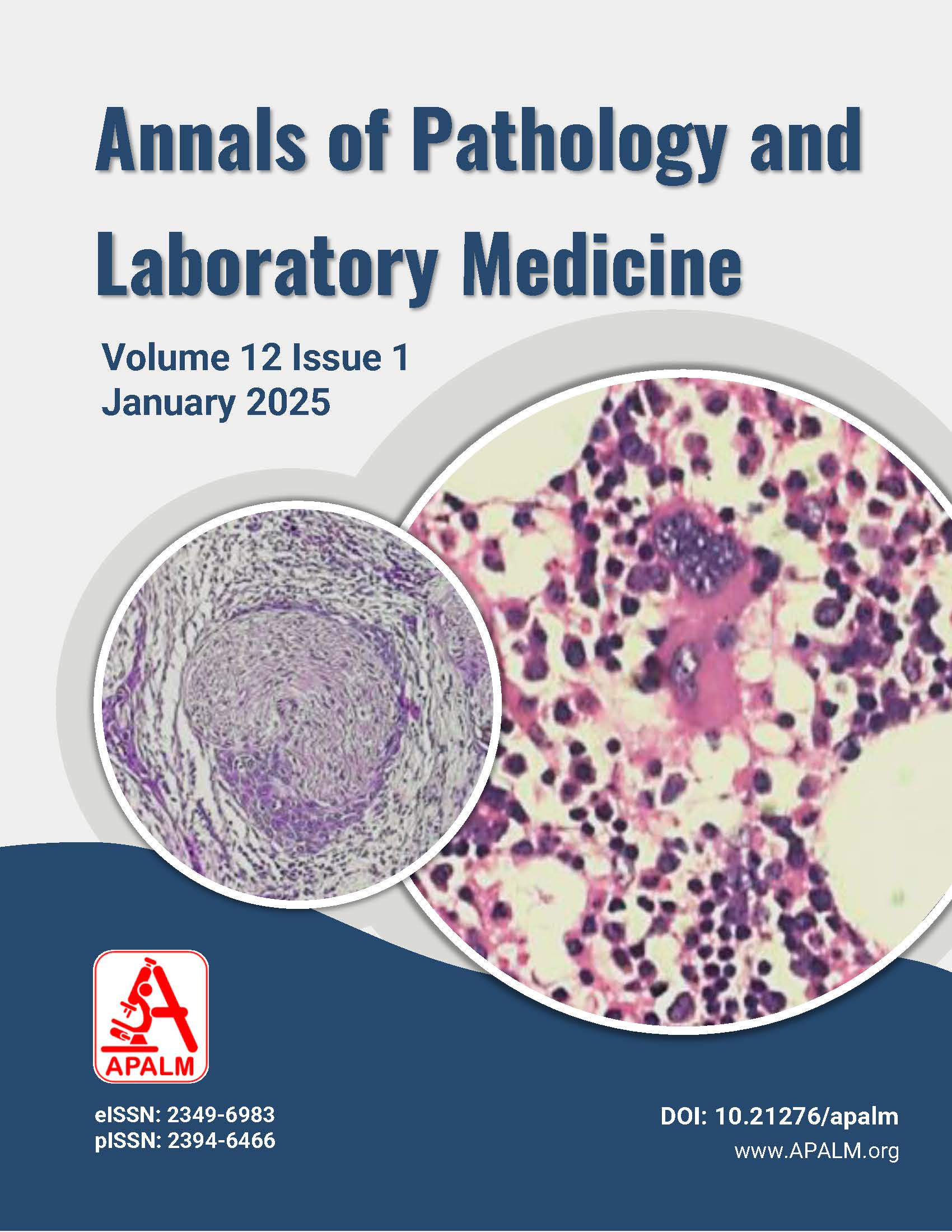A Study of Prognostic Indicators in Oral Cavity Squamous Cell Carcinoma in a Tertiary Care Institution
DOI:
https://doi.org/10.21276/apalm.3423Keywords:
oral squamous cell carcinoma, depth of invasion, worst pattern of invasion, prognosisAbstract
Background: Oral carcinoma is ranked as the sixth most common type of cancer worldwide, with India harboring one-third of the overall burden. Factors like smoke, tobacco, asbestos, silica, and other carcinogenic components may play a part. Late-stage detection leads to five-year survival rates of around 20% only. Hence, this study was designed to analyze the prognostic factors for oral squamous cell carcinoma (OSCC) at a tertiary care hospital. The aims were to assess the prevalence and frequency of OSCC, identify prognostic indicators in the specimens received to predict outcomes, and follow up wherever possible.
Materials and Methods: Parameters like depth of invasion, worst pattern of invasion, lymphocyte response, perineural invasion, resection margin status, lymphovascular invasion, and extranodal extension were studied.
Results: The majority of the study had a type 1 WPOI and type 1 LHR response. Perineural invasion, lymphovascular invasion, and extranodal spread were seen in advanced cases.
Conclusion: Key factors contributing to poor prognosis included age, smoking or tobacco use, and a higher depth of invasion (>10 mm). Perineural or lymphovascular/extranodal spread and a higher grade of WPOI were significantly associated with poor prognosis.
References
1. Gupta B, Bray F, Kumar N, Johnson NW. Associations between oral hygiene habits, diet, tobacco and alcohol and risk of oral cancer: a case–control study from India. Cancer Epidemiol. 2017;51:7–14.
2. Ajay P, Ashwinirani S, Nayak A, Suragimath G, Kamala K, Sande A, et al. Oral cancer prevalence in Western population of Maharashtra, India, for a period of 5 years. J Oral Res Rev. 2018;10:11.
3. Veluthattil A, Sudha S, Kandasamy S, Chakkalakkoombil S. Effect of hypofractionated, palliative radiotherapy on quality of life in late-stage oral cavity cancer: a prospective clinical trial. Indian J Palliat Care. 2019;25:383.
4. Jadhav KB, Gupta N. Clinicopathological prognostic implicators of oral squamous cell carcinoma: need to understand and revise. N Am J Med Sci. 2013;5(12):671–9.
5. Acharya S, Tayaar AS. Analysis of clinical and histopathological profiles of oral squamous cell carcinoma in young Indian adults: a retrospective study. J Dent Sci. 2012;7:224–30.
6. Tandon A, Bordoloi B, Jaiswal R, Srivastava A, Singh RB, Shafique U. Demographic and clinicopathological profile of oral squamous cell carcinoma patients of North India: a retrospective institutional study. SRM J Res Dent Sci. 2018;9:114–8.
7. Singh M, Prasad CP, Singh TD, Kumar L. Cancer research in India: challenges & opportunities. Indian J Med Res. 2018;148:362–5.
8. Shimizu S, Miyazaki A, Sonoda T, et al. Tumor budding is an independent prognostic marker in early stage oral squamous cell carcinoma: with special reference to the mode of invasion and worst pattern of invasion. PLoS One. 2018;13:e0195451.
9. Li C, Lan Y, Jiang R. Molecular and cellular mechanisms of palate development. J Dent Res. 2017;96(11):1184–91.
10. Chatterjee D, Bansal V, Malik V, et al. Tumor budding and worse pattern of invasion can predict nodal metastasis in oral cancers and associated with poor survival in early-stage tumors. Ear Nose Throat J. 2019;98(7):E112–9.
11. Chaturvedi A, Husain N, Misra S, et al. Validation of the Brandwein Gensler Risk Model in patients of oral cavity squamous cell carcinoma in North India. Head Neck Pathol. 2020;14(3):616–22.
12. Faisal M, Abu Bakar M, Sarwar A, et al. Depth of invasion (DOI) as a predictor of cervical nodal metastasis and local recurrence in early stage squamous cell carcinoma of oral tongue (ESSCOT). PLoS One. 2018;13(8):e0202632.
13. Jardim JF, Francisco AL, Gondak R, et al. Prognostic impact of perineural invasion and lymphovascular invasion in advanced stage oral squamous cell carcinoma. Int J Oral Maxillofac Surg. 2015;44(1):23–8.
14. Matsushita Y, Yanamoto S, Takahashi H, et al. A clinicopathological study of perineural invasion and vascular invasion in oral tongue squamous cell carcinoma. Int J Oral Maxillofac Surg. 2015;44(5):543–8.
15. Sparano A, Weinstein G, Chalian A, Yodul M, Weber R. Multivariate predictors of occult neck metastasis in early oral tongue cancer. Otolaryngol Head Neck Surg. 2004;131:472–6.
16. Lim SC, Zhang S, Ishii G, et al. Predictive markers for late cervical metastasis in stage I and II invasive squamous cell carcinoma of the oral tongue. Clin Cancer Res. 2004;10(1 Pt 1):166–72.
17. Ganly I, Patel S, Shah J. Early-stage squamous cell cancer of the oral tongue—clinicopathologic features affecting outcome. Cancer. 2012;118:101–11.
18. Kurokawa H, Yamashita Y, Takeda S, Zhang M, Fukuyama H, Takahashi T. Risk factors for late cervical lymph node metastases in patients with stage I or II carcinoma of the tongue. Head Neck. 2002;24:731–6.
Downloads
Published
Issue
Section
License
Copyright (c) 2024 ASAWARI BHARAT JADHAV, Bhavana Madhukar Bharambe, Dipali Suresh Ahire, Rajeshwar Suresh Bute, Saumya Trivedi

This work is licensed under a Creative Commons Attribution 4.0 International License.
Authors who publish with this journal agree to the following terms:
- Authors retain copyright and grant the journal right of first publication with the work simultaneously licensed under a Creative Commons Attribution License that allows others to share the work with an acknowledgement of the work's authorship and initial publication in this journal.
- Authors are able to enter into separate, additional contractual arrangements for the non-exclusive distribution of the journal's published version of the work (e.g., post it to an institutional repository or publish it in a book), with an acknowledgement of its initial publication in this journal.
- Authors are permitted and encouraged to post their work online (e.g., in institutional repositories or on their website) prior to and during the submission process, as it can lead to productive exchanges, as well as earlier and greater citation of published work (See The Effect of Open Access at http://opcit.eprints.org/oacitation-biblio.html).










